一、前言
本课程的难度较高,需要将Servlet原理和IO课程全部学完。
二、当前项目使用方式
(1).自定义servlet
自定义servlet需要实现@WebServlet并且实现name和urlMapping
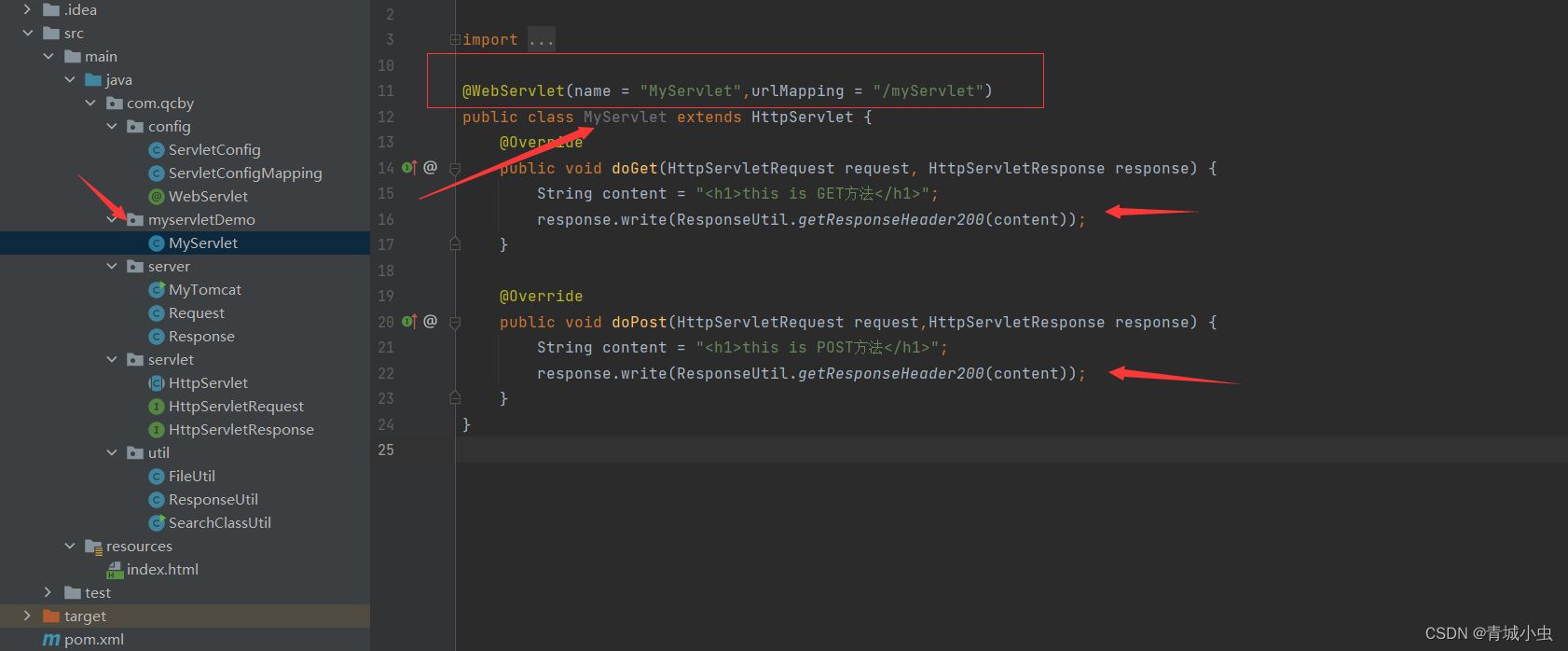
重启进行访问
http://localhost:8090/myServlet
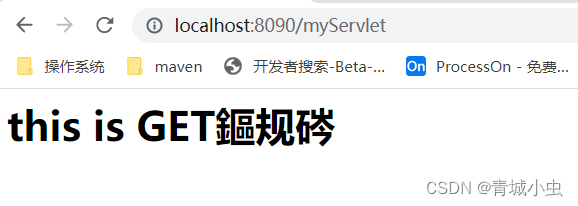
(2).自定义html

重启进行访问
http://localhost:8090/index.html

(3).关于servlet位置
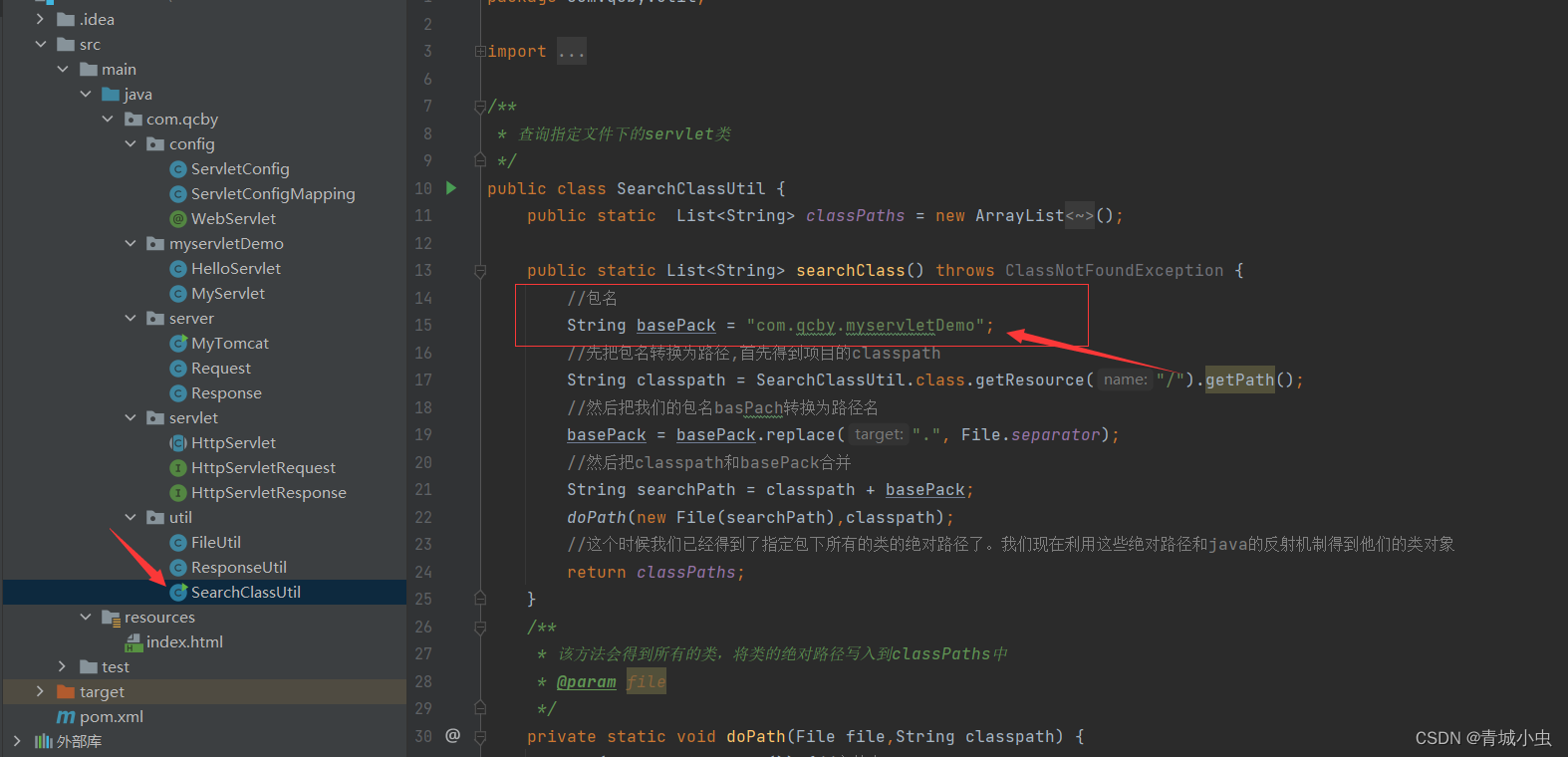
在SearchClassUtil类当中可以设置servlet包的位置
三、关于web须知
我们本次设计的tomcat能够将用户请求的资源进行返回
资源分类
1.静态资源:所有用户访问后,得到的结果都是一样的,称为静态资源。静态资源可以直接被浏览器解析。*例如:html/css/jpg/js..
2.动态资源:每个用户访问相同的资源后,得到的结果可能不一样,称为动态资源。动态资源被访问后需要先转化为静态资源,再返回给浏览器,浏览器进行解析*例如:servlet/jsp ...
四、tomcat设计原理
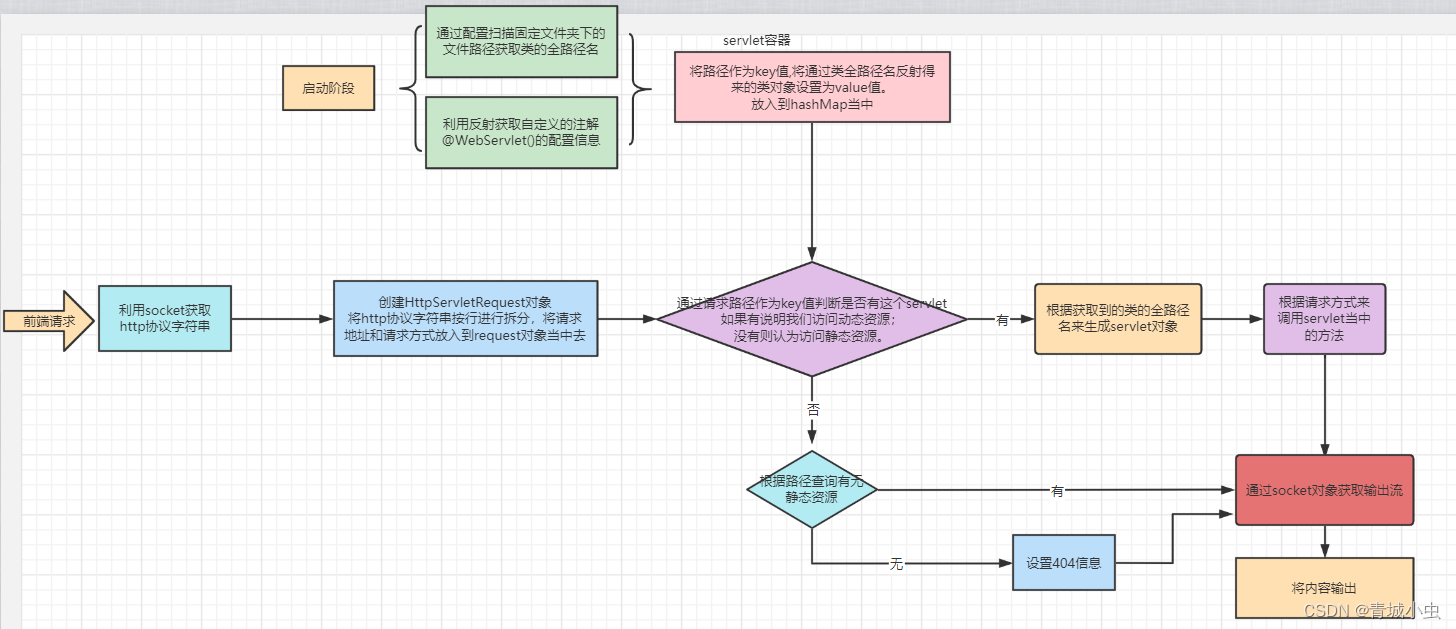
五、实现tomcat对静态资源的访问
(1).创建maven项目
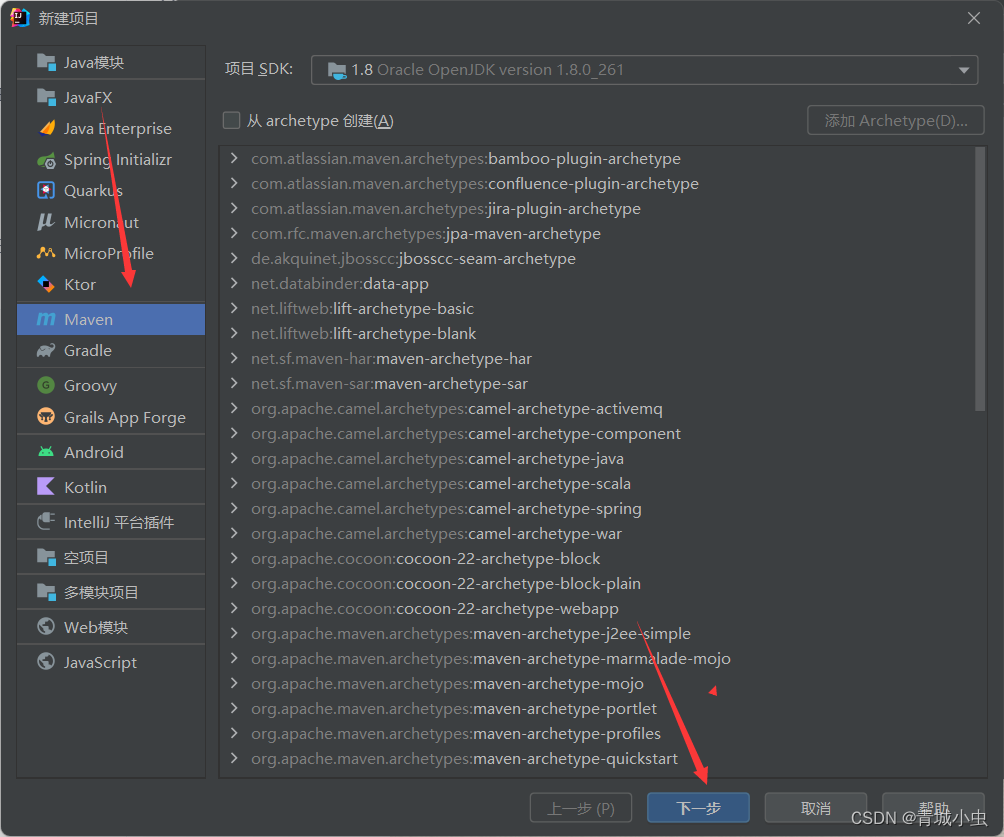
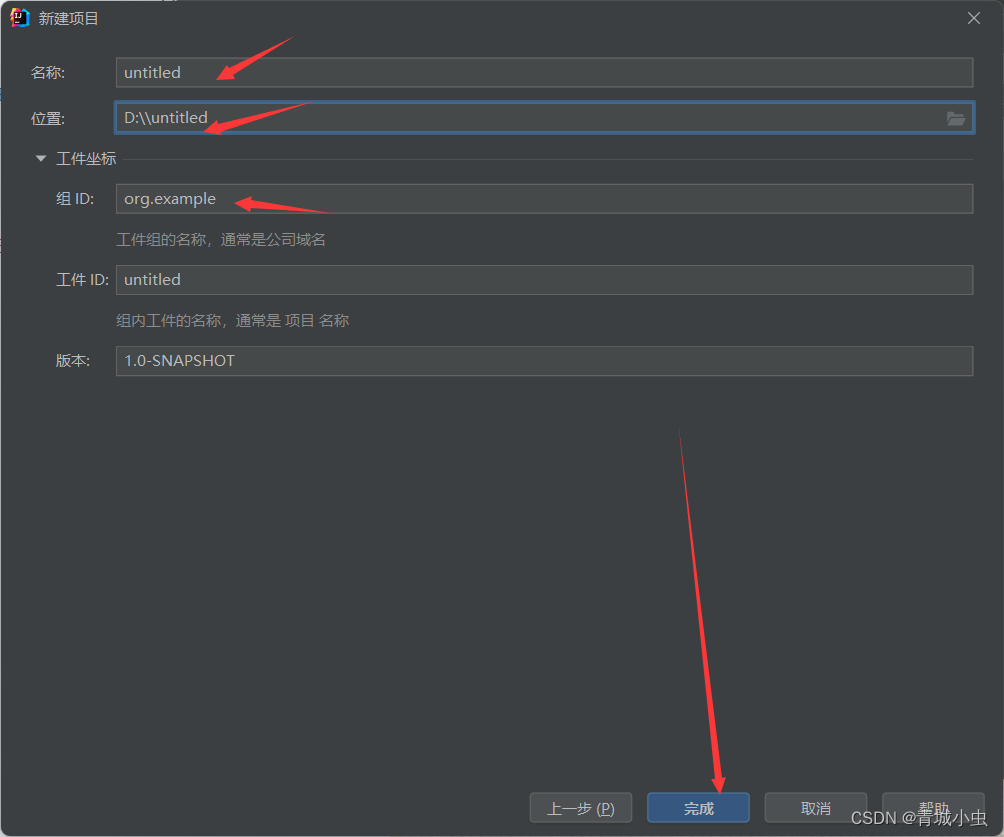
(2).tomcat启动阶段
配置HttpServlet
创建HttpServletRequest接口
public interface HttpServletRequest {public String getUrl();public void setUrl(String url);public String getMethod();public void setMethod(String method);
}
创建HttpServletResponse接口
public interface HttpServletResponse {void write(String context) throws IOException;
}
创建HttpServlet
/*** class HttpServlet*/
public abstract class HttpServlet {public abstract void doGet(HttpServletRequest request, HttpServletResponse response) throws IOException;public abstract void doPost(HttpServletRequest request,HttpServletResponse response);/*** HttpServlet 实现service方法*/public void service(HttpServletRequest request,HttpServletResponse response) throws IOException {if("GET".equals(request.getMethod())){doGet(request,response);}else if("POST".equals(request.getMethod())){doPost(request,response);}}}
创建工具类,描述返回的信息
/*** 返回信息工具类*/
public class ResponseUtil {public static final String responseHeader200 = "HTTP/1.1 200 \r\n"+"Content-Type:text/html \r\n"+"\r\n";public static String getResponseHeader404(){return "HTTP/1.1 404 \r\n"+"Content-Type:text/html \r\n"+"\r\n" + "404";}public static String getResponseHeader200(String context){return "HTTP/1.1 200 \r\n"+"Content-Type:text/html \r\n"+"\r\n" + context;}
}
配置注解信息
@Retention(RetentionPolicy.RUNTIME) //注解的生命周期,运行期间保留
@Target(value = {ElementType.TYPE,ElementType.FIELD}) // 该注解作用在类上边
public @interface WebServlet {String urlMapping() default ""; //自定义的servlet路径
}
配置servlet容器
创建ServletConfig存储注解信息
/*** 注解上的信息*/
public class ServletConfig {private String urlMapping; //2.urlprivate String classpath; //3.类的全路径名public ServletConfig(String urlMapping,String classpath){this.classpath = classpath;this.urlMapping = urlMapping;}public String getUrlMapping() {return urlMapping;}public void setUrlMapping(String urlMapping) {this.urlMapping = urlMapping;}public String getClasspath() {return classpath;}public void setClasspath(String classpath) {this.classpath = classpath;}
}
工具类,获取servlet的全路径名
/*** 扫描指定包,获取该包下所有的类的全路径信息*/
public class SearchClassUtil {public static List<String> classPaths = new ArrayList<String>();public static List<String> searchClass(){//需要扫描的包名String basePack = "com.qcby.webapp";//将获取到的包名转换为路径String classPath = SearchClassUtil.class.getResource("/").getPath();basePack = basePack.replace(".", File.separator);String searchPath = classPath + basePack;doPath(new File(searchPath),classPath);//这个时候我们已经得到了指定包下所有的类的绝对路径了。我们现在利用这些绝对路径和java的反射机制得到他们的类对象return classPaths;}/*** 该方法会得到所有的类,将类的绝对路径写入到classPaths中* @param file*/private static void doPath(File file,String classpath) {if (file.isDirectory()) {//文件夹//文件夹我们就递归File[] files = file.listFiles();for (File f1 : files) {doPath(f1,classpath);}} else {//标准文件//标准文件我们就判断是否是class文件if (file.getName().endsWith(".class")) {String path = file.getPath().replace(classpath.replace("/","\\").replaceFirst("\\\\",""),"").replace("\\",".").replace(".class","");//如果是class文件我们就放入我们的集合中。classPaths.add(path);}}}public static void main(String[] args) {List<String> classes = SearchClassUtil.searchClass();for (String s: classes) {System.out.println(s);}}
}
创建ServletConfigMapping生成servlet容器
/*** servlet容器*/
public class ServletConfigMapping {//定义一个集合用来存储自定义servlet的配置信息private static List<ServletConfig> configs = new ArrayList<>();//定义servlet容器public static Map<String,Class<HttpServlet>> classMap = new HashMap<>();//解析注解 ---- 为了实现当mytomcat类启动的时候就将webapp下边所有的类的注解信息获取到我们需要写一个static代码块static {//1.获取webapp包下有哪些类List<String> classPaths = SearchClassUtil.searchClass();//2.获取类的注解信息for (String classpath: classPaths) {try {//利用反射获取类的注解信息getMessage(classpath);} catch (ClassNotFoundException e) {e.printStackTrace();}}}//利用反射获取类的注解信息public static void getMessage(String classPath) throws ClassNotFoundException {Class clazz = Class.forName(classPath);//注解对象WebServlet webServlet = (WebServlet) clazz.getDeclaredAnnotation(WebServlet.class);//将解析的信息放入到集合当中configs.add(new ServletConfig(webServlet.urlMapping(),classPath));}//初始化类容器public static void initServlet() throws ClassNotFoundException {for (ServletConfig servletConfig: configs) {// 将servlet对象和 url请求地址放入到 map集合当中去classMap.put(servletConfig.getUrlMapping(), (Class<HttpServlet>) Class.forName(servletConfig.getClasspath()));}}
}
(3).接收前端请求
创建Request类接收前端数据并实现HttpServletRequest接口
public class Request implements HttpServletRequest {//请求的地址private String url;//请求的方式private String Method;public String getUrl() {return url;}public void setUrl(String url) {this.url = url;}public String getMethod() {return Method;}public void setMethod(String method) {Method = method;}
}
创建Response类用来实现HttpServletResponse
public class Response implements HttpServletResponse {//输出流private OutputStream outputStream;public Response(OutputStream outputStream){this.outputStream = outputStream;}/*** 返回动态资源* @param context*/public void write(String context) throws IOException {outputStream.write(context.getBytes());}/*** 返回静态资源*/public void writeHtml(String path) throws Exception {String resourcesPath = FileUtil.getResoucePath(path);File file = new File(resourcesPath);if(file.exists()){//静态文件存在System.out.println("静态文件存在");FileUtil.writeFile(file,outputStream);}else {System.out.println("静态文件不存在");write(ResponseUtil.getResponseHeader404());}}
}
工具类获取静态资源
/*** 该类的主要作用是进行读取文件*/
public class FileUtil {public static boolean witeFile(InputStream inputStream, OutputStream outputStream){boolean success = false ;BufferedInputStream bufferedInputStream ;BufferedOutputStream bufferedOutputStream;try {bufferedInputStream = new BufferedInputStream(inputStream);bufferedOutputStream = new BufferedOutputStream(outputStream);bufferedOutputStream.write(ResponseUtil.responseHeader200.getBytes());int count = 0;while (count == 0){count = inputStream.available();}int fileSize = inputStream.available();long written = 0;int beteSize = 1024;byte[] bytes = new byte[beteSize];while (written < fileSize){if(written + beteSize > fileSize){beteSize = (int)(fileSize - written);bytes = new byte[beteSize];}bufferedInputStream.read(bytes);bufferedOutputStream.write(bytes);bufferedOutputStream.flush();written += beteSize;}success = true;} catch (IOException e) {e.printStackTrace();}return success;}public static boolean writeFile(File file,OutputStream outputStream) throws Exception{return witeFile(new FileInputStream(file),outputStream);}public static String getResoucePath(String path){String resource = FileUtil.class.getResource("/").getPath();return resource + "\\" + path;}}获取输入流信息,获取访问方式和访问地址
public class MyTomcat {Request request = new Request();//启动tomcat主方法public void startUp() throws IOException, ClassNotFoundException {//1.定义socket对象,监听8080端口ServerSocket serverSocket = new ServerSocket(8080);while (true){Socket socket = serverSocket.accept();//等待接收 BIOSystem.out.println("有用户请求过来了.....");// 给每一个请求都开启一个线程处理信息new Thread(new Runnable() {@Overridepublic void run() {try {杜凯(socket);} catch (Exception e) {e.printStackTrace();}}}).start();}}//2.创建出入流,读取用户请求信息public void 杜凯(Socket socket) throws Exception {//创建输入流InputStream inputStream = socket.getInputStream();//解析输入流getInputStream(inputStream);socket.close();}public void getInputStream(InputStream inputStream) throws IOException {//将bit流转为文字信息int count = 0;while (count == 0){count = inputStream.available();}byte[] bytes = new byte[count];inputStream.read(bytes);String Context = new String(bytes);System.out.println(Context);//解析数据if(Context.equals("")){System.out.println("你输入了一个空请求");}else {String firstLine = Context.split("\\n")[0]; //根据换行来获取第一行数据request.setUrl(firstLine.split("\\s")[1]);request.setMethod(firstLine.split("\\s")[0]);}}public static void main(String[] args) throws IOException, ClassNotFoundException {MyTomcat myTomcat = new MyTomcat();myTomcat.startUp();}}
加载tomcat启动配置,判断访问内容时否是静态资源
public class MyTomcat {Request request = new Request();/*** servlet分发器* @param request* @throws InstantiationException* @throws IllegalAccessException*/public void dispatch(Request request, Response response) throws Exception {//根据请求的信息来获取servlet类Class<HttpServlet> servletClass = ServletConfigMapping.classMap.get(request.getUrl());//真实的创建servlet对象if(servletClass !=null){HttpServlet servlet = servletClass.newInstance();servlet.service(request,response);}else {response.write(ResponseUtil.getResponseHeader404());}}//启动tomcat主方法public void startUp() throws IOException, ClassNotFoundException {//加载servlet信息ServletConfigMapping.initServlet();//1.定义socket对象,监听8080端口ServerSocket serverSocket = new ServerSocket(8080);while (true){Socket socket = serverSocket.accept();//等待接收 BIOSystem.out.println("有用户请求过来了.....");// 给每一个请求都开启一个线程处理信息new Thread(new Runnable() {@Overridepublic void run() {try {杜凯(socket);} catch (Exception e) {e.printStackTrace();}}}).start();}}//2.创建出入流,读取用户请求信息public void 杜凯(Socket socket) throws Exception {//创建输入流InputStream inputStream = socket.getInputStream();//解析输入流getInputStream(inputStream);//输出流Response response = new Response(socket.getOutputStream());//根据url判断是静态资源还是动态资源if(request.getUrl().equals("")){//没有访问数据response.write(ResponseUtil.getResponseHeader404());}else if(ServletConfigMapping.classMap.get(request.getUrl()) == null){//访问静态资源response.writeHtml(request.getUrl());}else {//访问动态资源dispatch(request,response);}socket.close();}public void getInputStream(InputStream inputStream) throws IOException {//将bit流转为文字信息int count = 0;while (count == 0){count = inputStream.available();}byte[] bytes = new byte[count];inputStream.read(bytes);String Context = new String(bytes);System.out.println(Context);//解析数据if(Context.equals("")){System.out.println("你输入了一个空请求");}else {String firstLine = Context.split("\\n")[0]; //根据换行来获取第一行数据request.setUrl(firstLine.split("\\s")[1]);request.setMethod(firstLine.split("\\s")[0]);}}public static void main(String[] args) throws IOException, ClassNotFoundException {MyTomcat myTomcat = new MyTomcat();myTomcat.startUp();}}






函数用法详解及增强函数)

makefile基础知识)



项目实战)





(至尊详解版))